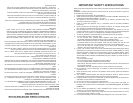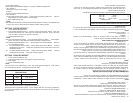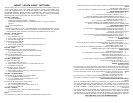IMPORTANT SAFETY INSTRUCTIONS
When using electrical appliances, basic safety precautions should be followed, including the
following:
WARNING - To reduce the risk of burns, electric shock, re, and injury to persons or exposure
to excessive microwave energy:
1. Read all instructions before using the appliance.
2. Read and follow the specic "PRECAUTIONS TO AVOID POSSIBLE EXPOSURE TO
EXCESSIVE MICROWAVE ENERGY" on page 1.
3. This appliance must be grounded. Connect only to properly grounded outlet. See
"grounding instructions” on page 3.
4. Install or locate this appliance only in accordance with the provided installation
instructions.
5. Some products such as whole eggs and sealed containers -for example, closed glass
jars- are able to explode and should not be heated in this oven.
6. Use this appliance only for its intended use as described in this manual. Do not use
corrosive chemicals or vapors in this appliance. This type of oven is specically designed
to heat, cook, or dry food. It is not designed for industrial or laboratory use.
7. As with any appliance, close supervision is necessary when used by children.
8. To reduce the risk of re in the oven cavity:
Do not overcook food. Carefully attend appliance when paper, plastic, or other
combustible materials are placed inside the oven to facilitate cooking.
Remove wire twist-ties from paper or plastic bags before placing bag in oven.
If materials inside the oven should ignite, keep oven door closed, turn oven off, and
disconnect the power cord or shut off power at the fuse or circuit breaker panel.
Do not use the cavity for storage purposes. Do not leave paper products, cooking
utensils or food in the cavity when not in use.
9. Liquids, such as water, coffee, or tea can be overheated beyond the boiling point without
appearing to be boiling due to surface tension of the liquid. Visible bubbling or boiling
when the container is removed from the microwave oven is not always present. THEIS
COULD RESULT IN VERY HOT LIQUIDS SUDDENLY BOILING OVER WHEN A
SPOON OR OTHER UTENSIL IS INSERTED INTO THE LIQUID. To reduce the risk of
injury to person:
Do not overheat the liquid.
Stir the liquid both before and halfway through heating it.
Do not use straight-sided containers with narrow necks.
After heating, allow the container to stand in the microwave oven for a short time before
removing the container.
Use extreme care when inserting a spoon or other utensil into the container.
10. Do not heat oil or fat for deep-frying. It is difcult to control the temperature of oil in
microwave oven.
11. Pierce foods with heavy skins such as potatoes, whole squash, apples and chestnuts
before cooking.
12. The contents of feeding bottles and baby jars should be stirred or shaken and the
temperature should be checked before serving in order to avoid burns.
13. Cooking utensils may become hot because of heat transferred from the heated food.
Potholders may be needed to handle the utensil.
14. Do not cover or block any openings on the appliance.
15. Do not store or use this appliance outdoors. Do not use this product near water, for
example, near a kitchen sink, in a wet basement, near a swimming pool, or similar
locations.
16. Do not operate this appliance if it has a damaged cord or a plug, if it is not working
properly or if it has been damaged or dropped.
17. Do not immerse cord or plug in water. Keep cord away from heated surface. Do not let
cord hang over edge of table or counter.
18. Use only thermometers, which are specically designed for use in microwave ovens.
INSTRUCCIONES IMPORTANTES DE
SEGURIDAD
Cuando se utilice cualquier electrodoméstico, debe de seguirse las siguientes instrucciones
básicas de seguridad:
ADVERTENCIA – Con el n de reducir el riesgo de quemaduras, descargas eléctricas,
fuego, daños personales o exposición a la energía microonda:
1. Lea todas las instrucciones antes de utilizar el electrodoméstico.
2. Lea y siga las “PRECAUCIONES PARA EVITAR LA POSIBLE EXPOSICIÓN A LA
EXCESIVA ENERGÍA MICROONDAS” en la página 1.
3. Este microondas debe de contar con conexión a tierra. Enchúfelo solamente a un
tomacorriente con conexión a tierra. Véase las “instrucciones de conexión a tierra en la
página 3.
4. Instale o coloque el electrodoméstico solamente de acuerdo a las instrucciones de
instalación que vienen con el aparato.
5. Algunos productos, como huevos enteros o envases cerrados herméticamente, por
ejemplo frascos de vidrio, pueden explotar por lo que no deben ser calentados en este
horno.
6. Utilice este electrodoméstico solo para los nes para los cuales has sido fabricado tal
como se describe en este manual.
No emplee químicos o vapores corrosivos en este aparato. Este tipo de horno ha sido
diseñado especícamente para calentar, cocer o deshidratar comida. No está diseñado
para nes industriales ni de laboratorio.
7. Como con cualquier otro electrodoméstico, debe supervisarse el uso de este aparato
si se trata de un niño quien lo use.
8. Con el n de reducir el riesgo que se produzca fuego dentro del horno:
• No cocine los alimentos demasiado. Tenga cuidado al usar, papel, plástico u otros
materiales combustibles dentro del horno si los usa para mejorar la cocción.
• Retire los precintos de alambre de las bolsas de papel o plástico antes de colocarlas
en el horno.
• Si algo se prendiera fuego dentro del horno, mantenga la puerta cerrada, apague el
horno y desenchúfelo o desconecte el circuito eléctrico principal en el panel de llaves.
• No almacene cosas dentro del horno. No deje productos de papel, utensilios de cocina
o comida dentro del horno mientras no esté en uso.
9. Los líquidos, tales como el agua, café o té pueden sobre calentarse más allá
del punto de ebullición sin parecer que estén hirviendo debido a la tensión de la
supercie del líquido. No siempre se verá el hervor o burbujeo cuando se retire
el líquido del horno. ESTO PUEDE OCASIONAR QUE LOS LÑIQUIDOS MUY
CALIENTES COMIENCEN A HERVIR CUADNO SE INSERTE UNA CHUCHARA
U OTRO UTENSILIO DENTRO DEL LÍQUIDO. Con el n de reducir daños
personales:
• No sobrecaliente el líquido.
• Remueva el líquido antes y durante el proceso de calentamiento.
• No utilice recipientes de bordes rectos y de cuellos angostos.
• Después de calentar, deje reposar el recipiente dentro del horno durante un rato antes
de retirarlo.
• Tenga sumo cuidado al insertar una cuchara u otros utensilios dentro del líquido.
10. No caliente aceite o grasa para freír. Es difícil controlar la temperatura del aceite
dentro del horno a microondas.
11. Perfore los alimentos con cáscaras gruesas tales como papas, calabazas enteras,
manzanas y castañas antes de cocerlos.
12. Los contenidos de biberones o frascos de alimentos para bebé deben de removerse
o sacudirse, y además, debe de vericarse la temperatura antes de servir para
evitar quemaduras.














